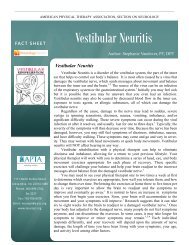Practice Guidelines for BPPV - Neurology Section
Practice Guidelines for BPPV - Neurology Section
Practice Guidelines for BPPV - Neurology Section
You also want an ePaper? Increase the reach of your titles
YUMPU automatically turns print PDFs into web optimized ePapers that Google loves.
Vestibular SIG Newsletter <strong>BPPV</strong> Special Edition<br />
Notably, Hanley and O’Dowd (2002) reported a<br />
Notably, Hanley and O’Dowd (2002) reported a<br />
positive predictive value of 83% and negative<br />
predictive value of 52%. A negative predictive value<br />
this high indicates that a negative Dix-Hallpike does<br />
not always rule out the diagnosis. In addition, patient<br />
exclusions described <strong>for</strong> this guideline include:<br />
persons with physical limitations including cervical<br />
stenosis, severe kyphoscoliosis, limited cervical<br />
range of motion, Down syndrome, severe rheumatoid<br />
arthritis, cervical radiculopathies, Paget’s disease,<br />
ankylosing spondylitis, low back dysfunction, spinal<br />
cord injuries and morbid obesity.<br />
Once a positive diagnosis of posterior canal<br />
<strong>BPPV</strong> is established, there are options <strong>for</strong> treating<br />
this condition. Based on the research examined, both<br />
the AAN and the AAO-HNS concluded that the<br />
canalith repositioning procedure (CRP) (also called<br />
the canalith repositioning maneuver, the Epley<br />
without vibration and canalith repositioning<br />
technique) is the most effective treatment option and<br />
should be offered to persons of all age diagnosed<br />
with this type of <strong>BPPV</strong>. This recommendation was<br />
described by the AAN as being Level A; there was<br />
sufficient high quality research to back the<br />
recommendation without reservation. The CRP<br />
begins in the same position the Dix-Hallpike ends.<br />
Once the nystagmus subsides, the examiner waits at<br />
least 30 seconds and then rotates the head 90 degrees<br />
toward the other side and again holds the position<br />
until the nystagmus subsides plus 30 seconds. Next,<br />
the examiner rolls the patient on to their side, tucks<br />
the chin and holds this position <strong>for</strong> the same<br />
parameters. Finally the patient is assisted in to a<br />
sitting position, coming up with the chin tucked.<br />
The other treatments examined by both the<br />
AAN and the AAO-HNS included “observation” of<br />
the condition which involved watching the person<br />
diagnosed with <strong>BPPV</strong> <strong>for</strong> complications and waiting<br />
<strong>for</strong> a spontaneous resolution. Two other treatments<br />
described were the Semont (Liberatory), which is a<br />
more rapid maneuver typically described <strong>for</strong><br />
cupulolithiasis and Brandt-Daroff exercises. The<br />
AAN concluded that the Semont maneuver was the<br />
next most effective treatment <strong>for</strong> posterior canal<br />
<strong>BPPV</strong> but described the evidence <strong>for</strong> this treatment<br />
as being Level C<br />
<strong>BPPV</strong> <strong>Practice</strong> <strong>Guidelines</strong> (cont.)<br />
3<br />
The AAN concluded that the Semont maneuver was<br />
and classified as only “possibly effective” due to the<br />
limited amount of research. The Brandt-Daroff<br />
exercises were found to be significantly less effective<br />
than both the CRP and Semont maneuver.<br />
The AAN also investigated the efficacy of using<br />
mastoid vibration during a CRP when treating<br />
posterior canal <strong>BPPV</strong> as originally described by the<br />
Epley maneuver in 1992. After examining one Class<br />
II study, one Class III study and three Class IV<br />
studies, the conclusion was that “mastoid oscillation<br />
is probably of no added benefit to patients treated<br />
with CRP <strong>for</strong> posterior canal <strong>BPPV</strong>.” (Level C<br />
recommendation) (Fife et al, 2008)<br />
If the Dix-Hallpike test is<br />
completed and negative or if<br />
both sides tested produce<br />
nystagmus purely horizontal<br />
in nature, the diagnosis of<br />
lateral (horizontal) canal<br />
<strong>BPPV</strong> should be explored.<br />
The incidence of horizontal canal <strong>BPPV</strong><br />
accounts <strong>for</strong> between 10-17% cases of <strong>BPPV</strong> (Fife et<br />
al, 2008). The supine roll test (Pagnini-McClure<br />
maneuver) is typically used to diagnose this type of<br />
<strong>BPPV</strong>. To complete the roll test, the patient is<br />
positioned supine, the examiner lifts the head and<br />
quickly rotates it 90 degrees. Both sides are tested in<br />
this fashion. At the end of the test position the eyes<br />
are observed <strong>for</strong> nystagmus. If the lateral canals are<br />
affected, the nystagmus will beat either toward the<br />
uppermost ear (apogeotropic nystagmus), indicative<br />
of cupulolithiasis; or down toward the undermost ear<br />
(geotropic nystagmus), indicative of canalithiasis. A<br />
subjective report of vertigo during the test must be<br />
present to confirm the diagnosis and is used to guide<br />
the treatment.<br />
The AAN did not provide a recommendation<br />
regarding the use of the roll test to diagnose<br />
horizontal canal <strong>BPPV</strong>. The AAO-HNS examined<br />
the existing research behind this test and<br />
recommended its use but described the evidence<br />
Continued on page 8

















